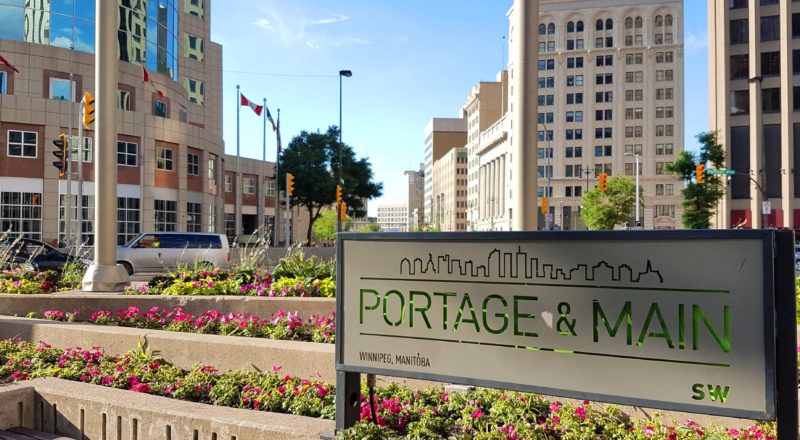
/ Blog
January 19, 2024
The Heart Of Winnipeg: 150 Years At Portage And Main
For the duration of 2024, Winnipeg is celebrating 150 years as a city! This exciting anniversary is a time to both look back at our history in order to understand our present, and to look forward, making good decisions for our future. We marvel at the progress we have made and the obstacles we have overcome. We recognize our mistakes, striving to learn and not repeat them. We dream big and plan for wonderful things, truly believing that Winnipeg is a great city. As this year of festivities begin, we start at the heart of it all, the famous intersection of Portage and Main!

The intersection of Portage and Main looking south east in 2007.
Source: Robert Sweeney (print available in the Heritage Winnipeg store)
The City of Winnipeg was incorporated on November 8th, 1873. Covering about 500 hectares, the city was located on the western banks of the Red River and north of the Assiniboine River with an estimated population of just 1,869. It was not until January 5th, 1874, that Winnipeg’s first election was held, with Francis Evans Cornish being elected the first mayor. Winning the election 383-179 over William Fisher Luxton when only 388 people were registered to vote, Corish would give his oath of office at the first council meeting on January 19th, 1874. Winnipeg’s sesquicentennial celebrations are now held 150 years after that first council meeting, 151 years after the city was incorporated.
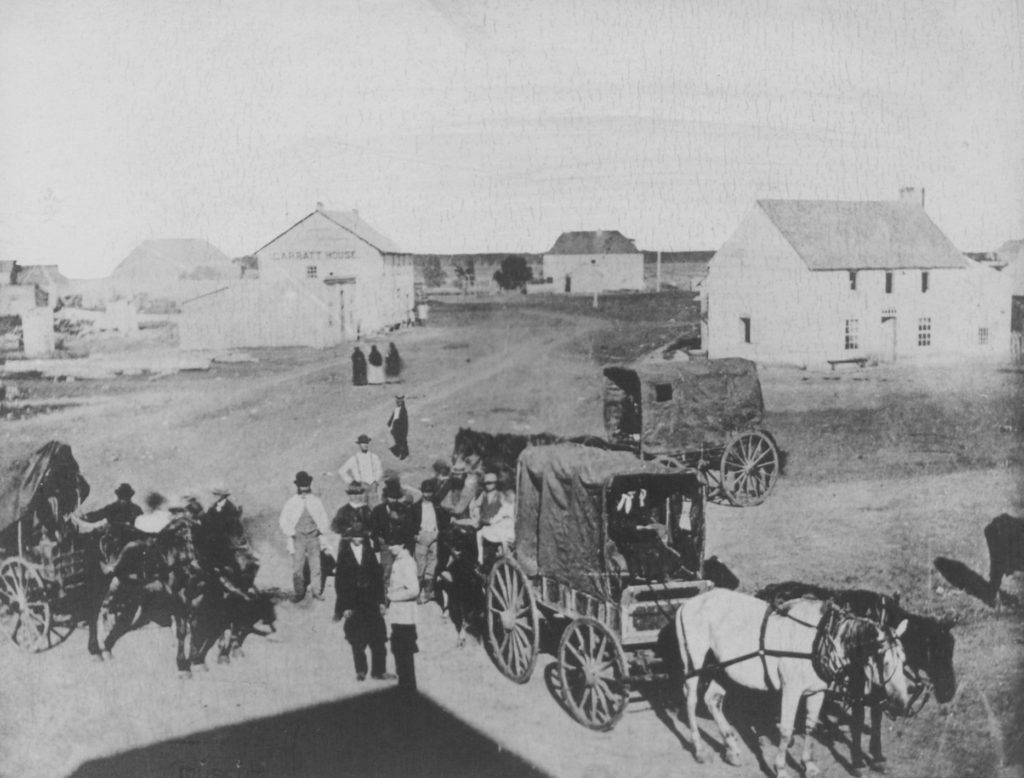
What would become the intersection of Portage and Main is seen here in 1872, looking east down what is now Portage Avenue East, toward the Red River.
Source: British Library (Public domain via Wikimedia Commons)
According to some reports Winnipeg’s first council meeting, which took place on a Monday at noon, was held in a building at the fabled corner of Portage Avenue and Main Street. The intersection known simply as Portage and Main, holds a special significance for Winnipeggers. It is near the geographical centre of our modern city, the junction point of two major transportation routes in Winnipeg. It is a meeting place to celebrate sorrow and success, the “crossroads of Canada”, rumoured to be the coldest and windiest corner in the nation, and home to many of downtown Winnipeg’s tallest buildings. It has witnessed the 1919 Winnipeg General Strike, celebrations at the end of both World Wars, and was where Bobby Hull signed a million dollar contract to the Winnipeg Jets in 1972. It was featured on the 1974 eight cent stamp, sung about in Randy Bachman and Neil Young’s 1992 hit song “Prairie Town”, featured in Trivial Pursuit and in the Canadian Edition of Monopoly. It truly is the spiritual heart of Winnipeg!
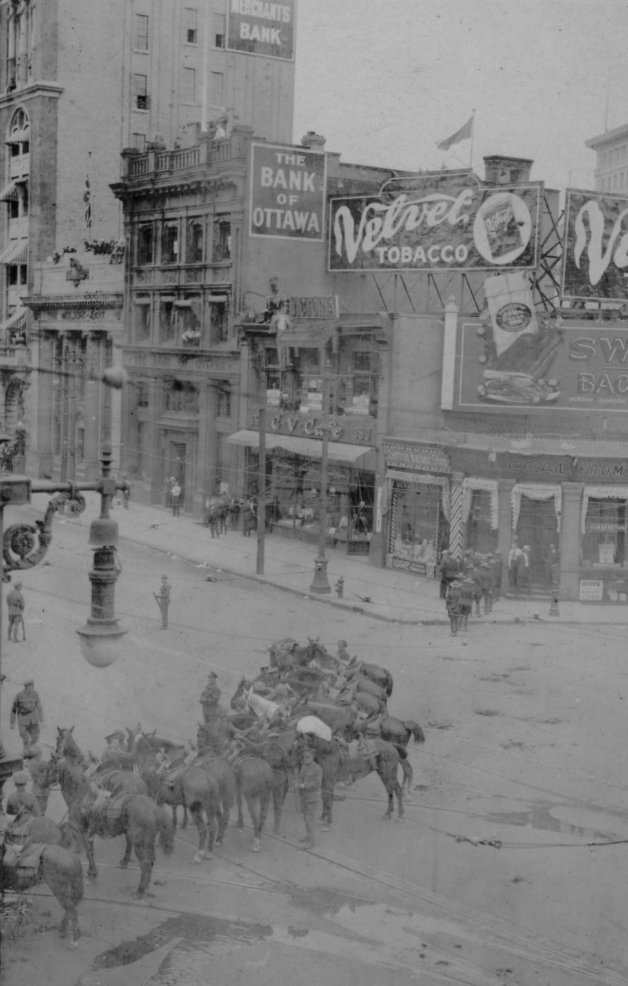
The Royal Northwest Mounted Police are seen here gathering at Portage and Main on June 21st, 1919 during the 1919 Winnipeg General Strike. They would charge at the strikers and the violence that ensued left two people dead. The event became known as “Bloody Saturday”.
Source: The Rob McInnes Postcard Collection (Winnipeg Public Library)
In 1862, Henry McKenney along with his half-brother and business partner, John Christian Schultz, opened a new general store where two main trails met in a perpendicular fashion. One trail ran north, connecting Upper Fort Garry to Lower Fort Garry, while the other trail that branched off of it led west, out onto the open prairie. While today we might see the location of the new store on the west side of the Red River as visionary, at the time people thought it was rather ill-conceived. Isolated and located too far from the only source of water, the river, it was also swampy land covered in bush. Today the location of the store would be approximately where the 201 Portage building stands. This was the beginning of the development of the intersection we now know as Portage and Main.
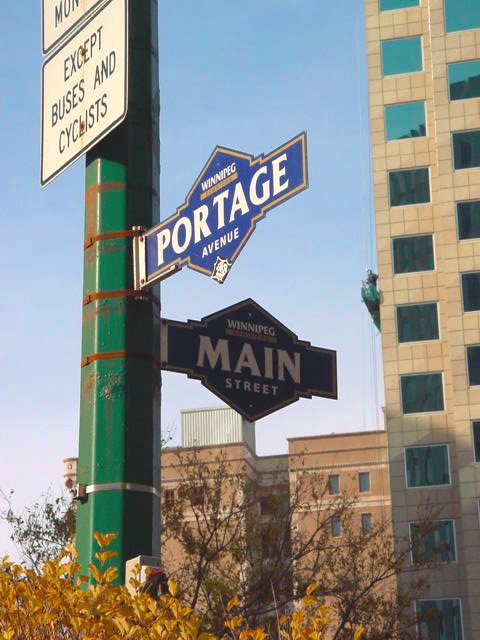
The street signs at the intersection of Portage and Main in October 2005.
Source: Susan E. MacDonald (CC BY-SA 3.0, Wikimedia Commons)
McKenney and Company moved into their new building, often called McKenney’s Building, in November 1862. It was a long two storey building with few windows, facing southeast to look towards Upper Fort Garry. The building was nicknamed “Noah’s Ark” for its appearance and the anticipated flooding of the surrounding area in the spring. Despite the naysayers, the store would prosper, causing land prices around it to rise and other buildings to be constructed in the area. A 1869 sketch of the area showed about 50 buildings of all kinds had been built within a quarter mile of the intersection, home to nearly 200 people.
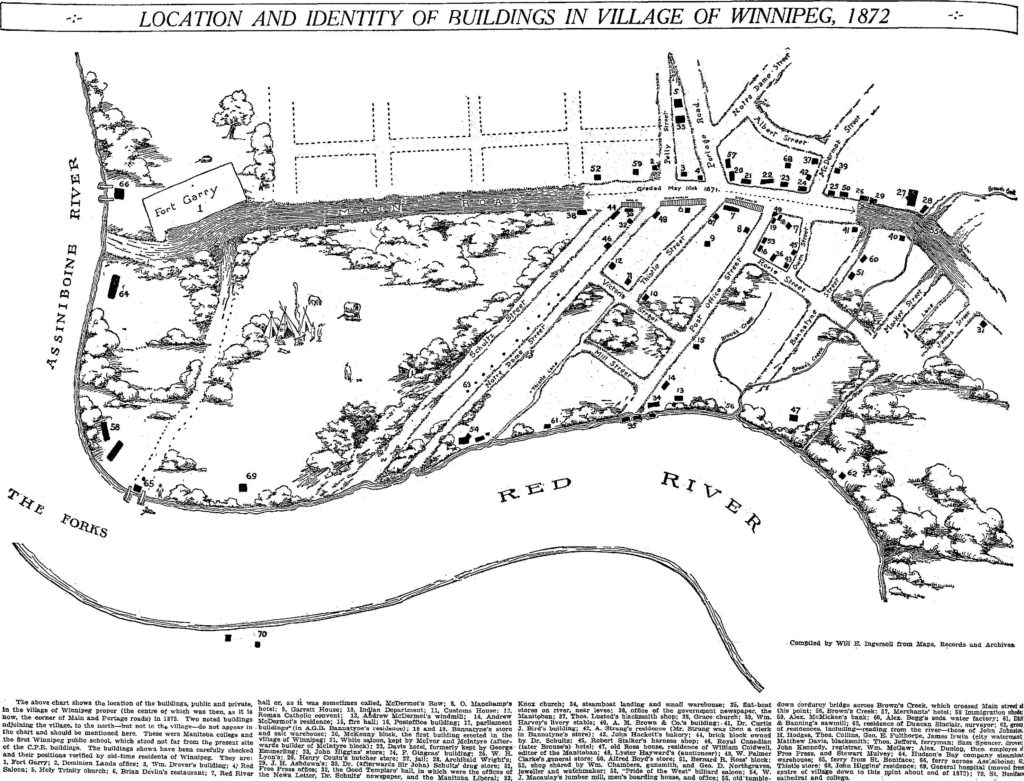
Building number 20 is listed as “McKenny block, the first building erected in the village of Winnipeg”. This would have been “Noah’s Ark”, built by Henry McKenney and John Christian Schultz in 1862. Linus Romulus Bentley’s building, the “flat boat store” which served as Winnipeg’s first “City Hall” does not appear on the map. It would have been located somewhere between buildings 21 (White saloon) and 22 (Davis hotel).
Source: Winnipeg Free Press, November 9, 1922, page 22
The roads that would become Main Street and Portage Avenue were surveyed in 1863 and formally established at 132 feet wide. This was not in anticipation of the great thoroughfares they would become, but to provide ample space for groups of carts travelling on these muddy roads and trying to avoid ruts and ambushes. Due to buildings already standing on the land of the newly surveyed roads and legal disputes, it was not until 1883 that the future Portage Avenue road was finally widened to its full potential. Additionally, the somewhat odd alignment of the intersection, not at right angles, was the result of accommodating the McKenney’s Building. The structure was built parallel to the boundaries of the river lot it was located on, not parallel to the north-south trail that would become Main Street.
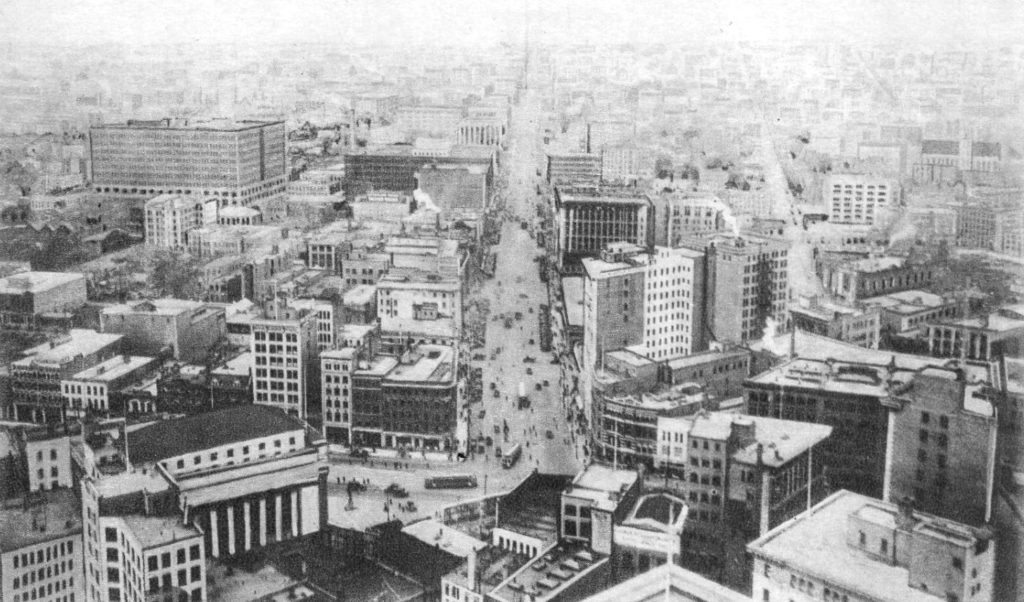
An aerial view of Portage and Main, looking west down Portage Avenue some time between 1924 and 1937.
Source: The Rob McInnes Postcard Collection (Winnipeg Public Library)
McKenney and Company was short-lived, with the partnership between McKenney and Schultz ending in 1864. McKenney continued to run the store for a few years, before renting the building out. It was long thought that one of the renters of McKenney’s Building at Portage and Main was the City of Winnipeg, where they supposedly held the city’s inaugural council meeting on the second floor in 1874. How fitting for Winnipeg’s first “City Hall” to be located at its symbolic heart! But alas, it turned out to be a misunderstanding, facts being confused as stories are passed through the generations.

Portage and Main in 1940, looking west down Portage Aveune.
Source: Photogelatine Engraving Co: Publisher (Public domain, Wikimedia Commons)
By 1874, the McKenney’s Building had become home to a hardware store run by Linus Romulus Bentley, McKenney’s son in law. At the same time, Bently owned a building further north along the same side of Main Street, built around 1870, known as the “flat boat store”. It would have been located where the parking lot on the west side of Main Street is, just north of today’s 201 Portage. Over time, the two buildings, both with nautical nicknames and associated with the same people, became hard to distinguish. When records indicated that Winnipeg’s first council meeting was held in Bentley’s Building, the “flat boat store” on Main Street, it was assumed that this was McKenney’s Building, “Noah’s Ark”. Fortunately, maps and other records from the era clearly indicate that “City Hall’ was located 125 feet north of McKenney’s Building, in Bentley’s “new” building.
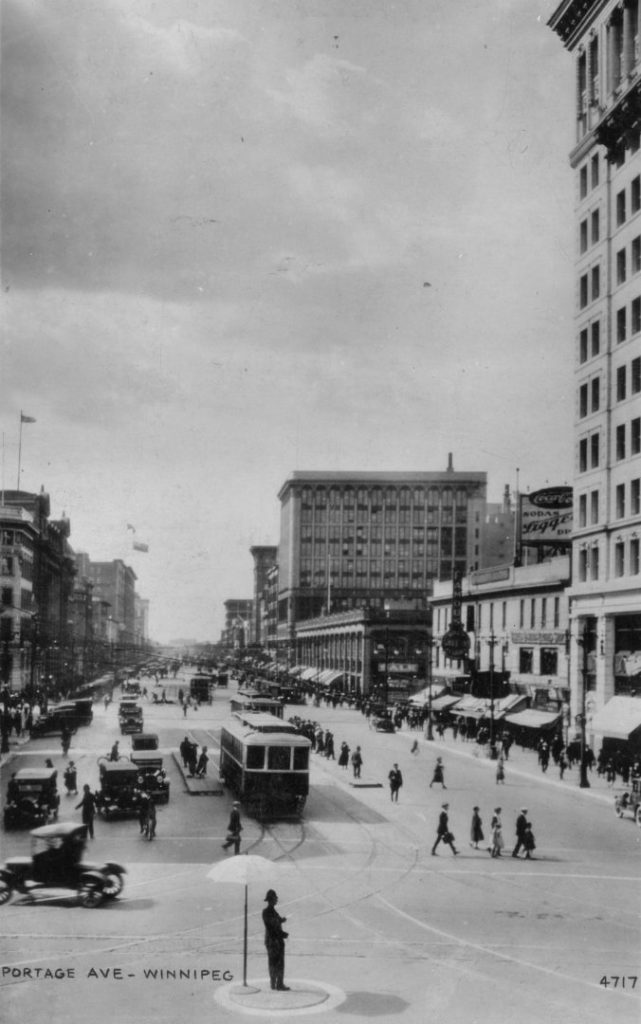
A policeman standing under an umbrella directs traffic at the intersection of Portage and Main.
Source: Public Historical Postcards (Winnipeg Public Library)
The “flat boat building” was a two story wooden structure with a general store on the ground floor and “City Hall” on the second. Mayor Cornish rented the space for one year, for which Bentley charged the city $450 in rent. Well appointed in short order for $340.39, the space functioned as the council room, police court and the mayor’s office, with space for a gallery and reporters. While that first meeting on January 19th, 1874 was rather dull, the gallery would have been full of people interested in seeing how this city worked. City Hall would depart the “flat boat building” in June of 1875.
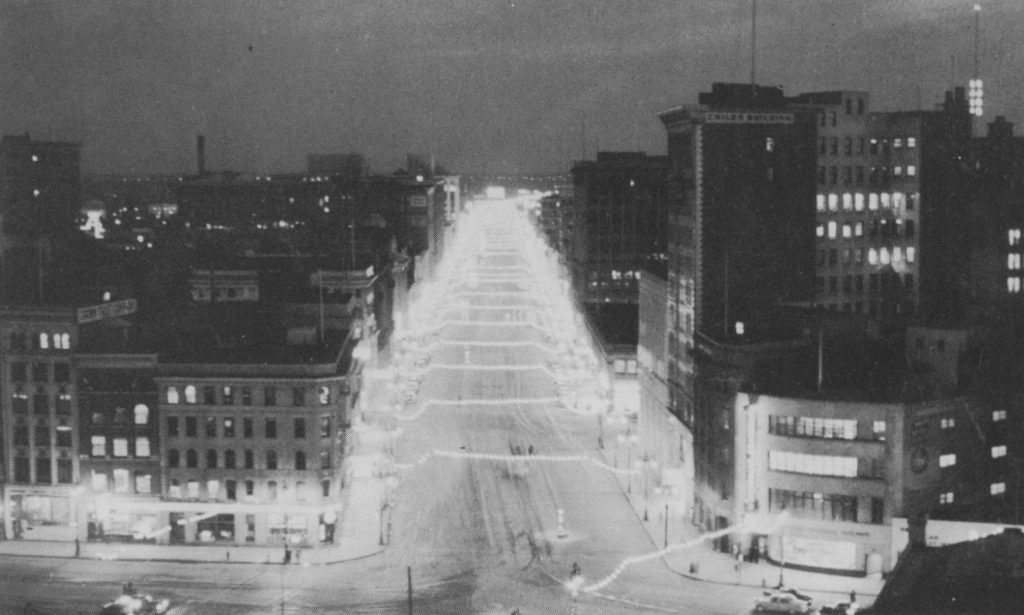
Looking west down an illuminated Portage Avenue from Main Street, some time between 1947 and 1954.
Source: Martin Berman Postcard Collection (Winnipeg Public Library)
McKenney sold his building at Portage and Main in 1876 and departed Winnipeg the next year, never to return. “Noah’s Ark” would be demolished in 1887, first replaced with two iterations of the Canadian National Railway’s office building, which eventually had the 33 storey Toronto-Dominion Centre office tower built over top of it in 1990. Winnipeg’s tallest building until 2021, it is now known as 201 Portage. Bentley’s “flat boat building” is thought to have burned down in a 1882 fire. It was replaced with the McIntyre Block, which burnt down and was rebuilt in 1898, sadly only to be demolished in 1979 by the owners. The property then became a surface parking lot, which is still in use today. It is certainly not a fitting use for an important historical location. Unfortunately, at the time nothing was more coveted in Winnipeg than a prime parking spot.
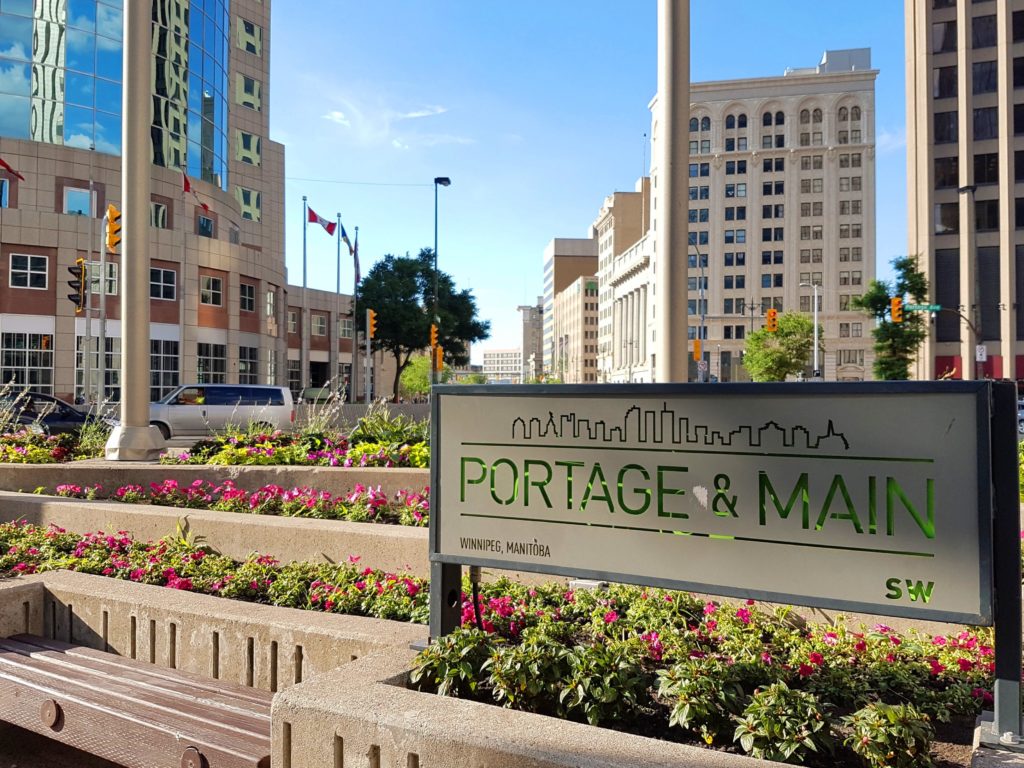
The south west corner of Portage and Main in June 2018 looking north down Main Street. 201 Portage is the large building dominating the left side of the image.
Source: Ccyyrree (CC BY-SA 4.0, via Wikimedia Commons)
In the past 150 years, Portage and Main has continued to transform. Along with 201 Portage, the 34 story Richardson Building opened at the north east corner in 1969, followed by the five story Scotiabank building at the southwest corner in 1979. It was also in 1979 that the controversial outdoor concrete barricades were erected at the intersection, forcing pedestrians to go underground to cross the street. A contentious plebiscite held in 2018 saw Winnipeggers vote to keep the barriers up, but much needed repairs to the intersection’s infrastructure below creates optimism that people might take back this intersection in the future. Today, the only historical building that stands is at the south east corner of the intersection, the monumental 1913 Bank of Montreal building, now owned by the Manitoba Métis Federation.
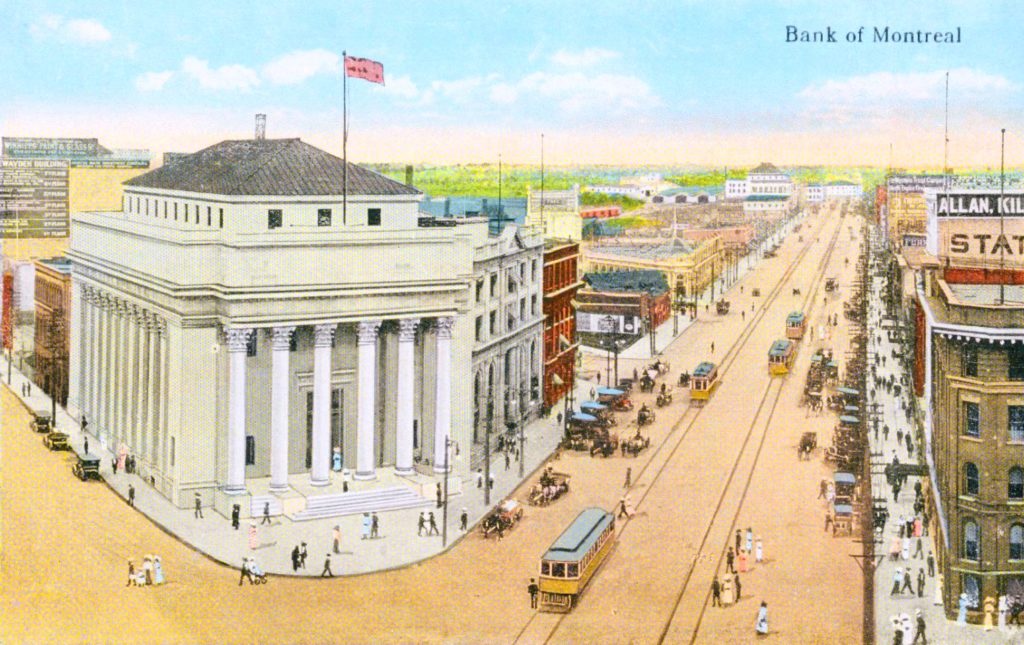
Reminiscent of a temple, the 1913 Bank of Montreal at the south east corner of Portage and Main is the last historical building standing at the intersection.
Source: Public Historical Postcards (Winnipeg Public Library)
Despite all these changes, Portage and Main retains its mythical status, an icon of the city where legends and folklore take root. It might not be the site of Winnipeg’s first “City Hall”, but it is a site with a rich history dating back long before the arrival of McKenney’s Building. The next time you find yourself passing by this intersection, do not forget to pause and admire our famous corner, Portage and Main, the heart of Winnipeg!
THANK YOU TO THE SPONSOR OF THIS BLOG POST:

Written by Heritage Winnipeg
SOURCES:
201 Portage Avenue | Winnipeg Architecture Foundation
Bank opens new building | Winnipeg Free Press - September 14, 1979, page 18
First city council meeting | Winnipeg Regional Real Estate News - January 16, 2014
History of Portage and Main wide open | Allan Levine - Winnipeg Free Press - November 9, 2017
List of tallest buildings in Winnipeg | Wikipedia - December 23, 2023
Manitoba History: Frank Cornish - The Man | Ruth Swan - Manitoba History - Number 9, Spring 1985
McKENNEY, HENRY | George F. Reynolds - Dictionary of Canadian Biography - 1982
Portage and Main | Wikipedia - September 27, 2023
Seven stories about Portage and Main | Christian Cassidy - West End Dumplings - June 1, 2012
Things you might not know about Portage and Main | CBC News - March 29, 2016
TIMELINE: The history behind Portage and Main | Kayla Rosen - CTV Winnipeg - October 16, 2018
Winnipeg General Strike of 1919 | J. Nolan Reilly - The Canadian Encyclopedia - November 28, 2023
Winnipeg's history | City of Winnipeg





